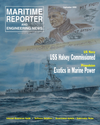
Page 26: of Maritime Reporter Magazine (September 2005)
Marine Propulsion Annual
Read this page in Pdf, Flash or Html5 edition of September 2005 Maritime Reporter Magazine
"Nothing fails like the right idea at the wrong time."
In this feature we present marine propulsion systems that were either too advanced for their time, did not stand the test of time, or, while not becoming universal practice, are still appreciated in special applications.
Star Performer
An exhibit at the excellent "Auto + Technik" tech- nology museum in Sinsheim, Germany is billed as an obsolete multi-row radial diesel engine from Russia.
Not so! St. Petersburg-based "Zvezda" is still in busi- ness and its radial diesels still a mainstay product. As in World War II they are used to power fast craft, including naval and governmental patrol vessels and the "Raketa" hydrofoils Russia sold to many other countries.
Zvezda means "star" in Russian and, as in German, radial engines are called "star engines." As with many unusual engines, power density is the Zvezda engine's rationale. With seven banks of six, eight or 16 cylin- ders each and almost 3.5 liters per cylinder, the Zvezda radial engine indeed crams a large displacement into a very small space. The largest, 112 cylinder version has an excellent power output of 7,350 kW, putting it in the power density class of smaller gas turbines. So, in spite of the problems of maintaining 42, 56 or 112 cylinders, the Zvezda diesel has stood the test of time as the prime mover of fast vessels.
The Inexhaustible Savannah
The ultimate expression of power density is
Einstein's famous equation E=mc². It tells us that ener- gy released in a nuclear reaction from a tiny mass of particles is to be multiplied not merely by the largest quantity in the universe, but by the square of the speed of light.
Thus a few kilos of nuclear fuel can produce a lot of energy for a long time, and in the 1950's and 1960's, atomic energy was seen as the solution to the world' s energy needs. Marine propulsion was on the agenda since, essentially, nuclear power creates steam and many ships were then still driven by steam turbines.
Following submarines, aircraft carriers and icebreak- ers, the first nuclear freighter, the NS Savannah was launched in 1962. She displaced 22,000 tons, and with a 20,300 hp propulsion system was designed to carry 8,500 tons of cargo, 60 passengers and 124 crew. Her speed and range were impressive - top speed 23 knots, cruising speed 21 knots and 336,000 miles on a single fuelling i.e. - about 14 times round the world.
Unfortunately NS Savannah was not commercially competitive. Accommodation for all those passengers restricted cargo space and a futuristic streamlined hull made stowing cargo difficult. A payload of 8,500 tons was a fraction of what many conventional ships could transport. Although a technical success, Savannah failed to convince buyers, in spite of its impressive fuel economy - an aspect which could only have improved during the coming oil crises. 26 Maritime Reporter & Engineering News
Marine Propulsion
False Starts and
Exotics in Marine Propulsion
The Inexhaustible Savannah
Often referred to as the "prettiest freighter afloat", the nuclear powered NS Savannah had a strikingly modern look. (Photo Credit: MarAd)
Star Performer
Zvezda radial diesels are original equipment on the Russian-built "Raketa" class hydrofoils. They were sold around the world, with examples operating in the Mediterranean. (Photo Credit www.hydrofoils.org)
MR SEPTEMBER 2005 #4 (25-32).qxd 9/1/2005 11:48 AM Page 26

 25
25

 27
27
